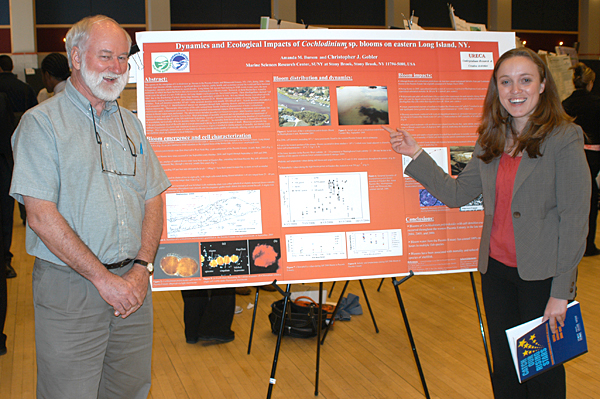Amanda Burson and Christopher J. Gobler, Dynamics and Ecological Impacts of Cochlodinium sp. Blooms in Eastern Estuaries of Long Island, NY
This project reports on the emergence of Cochlodinium sp. blooms in the Peconic Estuary and Shinnecock Estuary, NY, USA, during 2004 – 2006. Harmful algal blooms (HABs) represent a significant threat to fisheries, public health, and economies around the world and have increased in frequency, duration, and distribution in recent decades. Long Island, NY has not been lacking in HAB events in past years, the most proliferate of which has been the brown tide (Aureococcus anophagefferens) bloom events. However, as these blooms have waned in recent years the advent of a new HAB species for Long Island, Cochlodinium sp., has created concern. These dinoflagellates, deemed “red tides” due to the discoloring of waters during large blooms, are particularly common in Asia.
In Long Island, blooms were observed with temperatures ranging between 20-25oC and salinities ranging between 22-30. Blooms appeared in patches of varying degrees of cell densities. Peak cell densities exceeded 105 ml-1 while recurrent densities were usually 103-104 cell ml-1. At peak densities chlorophyll a levels exceeded 100 μg L-1. Identification of species was attempted through light, scanning electron, and thin-section transmission electron microscopy. Microscopic observations of the cells isolated from blooms displayed characteristics of both Cochlodinium polykrikoides and Cochlodinium catenatum. To determine potential environmental impacts 24 hr bioassay experiments with multiple fish species in bloom waters were performed. The species tested included juvenile Cyprinodon variegates, adult Fundulus majalis, adult Menidia menidia and adult Fundulus heteroclitus.
High percentages of mortality occurred and one potential cause was impairment of respiratory abilities as the gills of the fish underwent hyperplasia. Levels of mortality lowered with decreasing densities of Cochlodinium sp. to complete survival after 48 hr for densities below 103 cells ml-1. No mortality from frozen then thawed or filtered bloom water leads to the polysaccharide layer of the cells and/or a toxin associated with the layer as potential cause of death. Bioassays on juvenile bay scallops (Argopecten irradians) and American oysters (Crassostrea virginica) resulted in similar patterns of mortality and internal tissue damage. This seemingly annual event of Long Island has bloom concentrations capable of drastically affecting several species of finfish and shellfish which are important to local fisheries.
My involvement in this work was supported by funding from Undergraduate Research & Creative Activities (URECA), and the Evan Frankel Foundation.
Robert Hunter and Malcolm J. Bowman, Towards an Operational Storm Surge Prediction Model for the Northeast Seaboard
 The Stony Brook Storm Surge Project is investigating threats to the Metropolitan New York and Long Island areas from storm surges in an era of global climate change. We are developing an integrated meteorological-oceanographic-wave numerical model for real-time 60-hour forecasts of water level and coastal flooding using constantly-updated weather forecasts. Software is being developed to run daily a 9-member ensemble, using eight different meteorological forecasts and two ocean grids with different resolutions and domains. Throughout the past year, the model has been further refined by improving oceanographic model parameters and meteorological-oceanographic model integration. A new grid, with increased resolution and skill, has been tested on past storms, and the operational forecast model is being migrated to using it. This winter, we are collecting data from significant storm events for long term analysis of the model accuracy. Various data products for displaying and analyzing the predictions are being used for verification and improvement of the model. Our eventual goal is to provide a real-time warning system for conveying flooding threats to the public. Funded by New York Sea Grant.
The Stony Brook Storm Surge Project is investigating threats to the Metropolitan New York and Long Island areas from storm surges in an era of global climate change. We are developing an integrated meteorological-oceanographic-wave numerical model for real-time 60-hour forecasts of water level and coastal flooding using constantly-updated weather forecasts. Software is being developed to run daily a 9-member ensemble, using eight different meteorological forecasts and two ocean grids with different resolutions and domains. Throughout the past year, the model has been further refined by improving oceanographic model parameters and meteorological-oceanographic model integration. A new grid, with increased resolution and skill, has been tested on past storms, and the operational forecast model is being migrated to using it. This winter, we are collecting data from significant storm events for long term analysis of the model accuracy. Various data products for displaying and analyzing the predictions are being used for verification and improvement of the model. Our eventual goal is to provide a real-time warning system for conveying flooding threats to the public. Funded by New York Sea Grant.
Alexander Mintz and Malcolm J. Bowman, Short Term Oscillations Over the Northeastern Seaboard in Observations and Storm Surge Models
The Stony Brook Storm Surge Research Group (SBSS) is developing a coupled ocean atmospheric storm surge forecasting model for the northeastern seaboard, with emphasis on Metropolitan New York, New Jersey and Long Island. Both the model predictions and observations sometimes exhibit a “ringing” (T~6 hours), whose period is noticeably independent from tidal oscillations (T~12.42 hours) and whose origins are being investigated. We are investigating possible sources, both natural (e.g., wind gusts) and numerical (e.g., errors in wind stress formulation). Observed ringing in continental shelf seiching is most likely produced by sudden changes in wind velocity and/or direction (e.g., passage of a low pressure system). In such cases, this ringing is present in both observations and model predictions. However, on many occasions the models exhibit ringing without the presence of impulsive wind forcing. Such artifacts compromise the accuracy of the model and lead to large errors between predicted and actual (observed) storm surge. This investigation will hopefully identify the source of the ringing (e.g., inadequate boundary conditions, extreme bathymetric gradients, and errors in ingesting atmospheric wind predictions).






You must be logged in to post a comment.